To accelerate commercial district improvement you have to do more than build the one shiny new thing
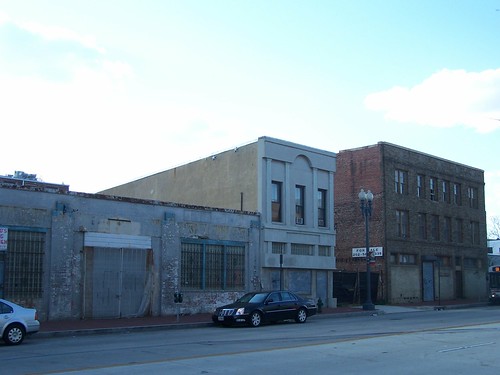 1200 block of 9th Street NW, three years after the DC Convention Center opened.
1200 block of 9th Street NW, three years after the DC Convention Center opened.The DC Convention Center opened in 2003 and c. 2005, I wrote a couple pieces about how while building the Convention Center was important, if they wanted the neighborhood commercial district around the center "to show well" simultaneous with the opening, there needed to have been a specific program created to invest in the storefronts and businesses located in the adjacent commercial district (on 9th Street mostly).
Otherwise the process is "trickle down" improvement and it can take decades.
That didn't occur, and it took 8 or more years before you finally started seeing a difference on 9th Street, and part of that was facilitated by the addition of a convention center hotel, a Marriott, at Massachusetts Avenue and 9th Street as well as the redevelopment of the O Street Market as a mixed use project spanning from 7th to 9th Streets ("O Street Market: Symbol of violence becomes a marker for D.C.'s resurgence," Washington Post)--so that's three projects not one.
This piece from 2015 references the earlier blog entries, "The time to plan for retail in and around the Convention Center was long before it opened in 2003 and certainly before 2015."
Kennedy Street streetscape project. Last summer, I meant to write about Kennedy Street NW where the city has been doing a streetscape reconstruction project, but instead of calling it a streetscape project, they called it a revitalization project. But merely renaming the process didn't make it so.
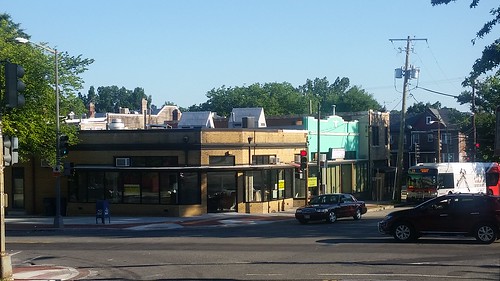 The façade improvement program for these buildings was coordinated by the Emory Beacon of Light (Church) Community Development Corporation.
The façade improvement program for these buildings was coordinated by the Emory Beacon of Light (Church) Community Development Corporation.During part of the reconstruction, a set of buildings at 3rd Street underwent a façade renovation and for the most part looked much better afterwards. I figured it was a deliberate, simultaneous project to increase the velocity and economic return on the streetscape project, but it happened to be coincidental.
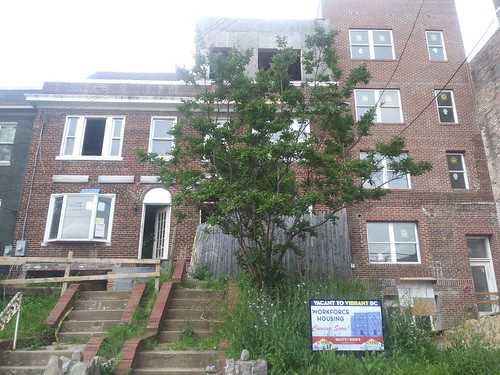 Buildings languishing on Kennedy Street, 2018.
Buildings languishing on Kennedy Street, 2018.But it made me realize how much more success would come about from such projects -- which are investments -- if there were wrap around or complementary investment-improvement programs designed to facilitate and accelerate overall improvement in a purposeful manner, rather than a trickle down approach.
This was around the time I was writing the series of articles about the Purple Line light rail project in Suburban Maryland, and how a "complementary transit network improvement program" is in order not only to make the Purple Line more successful, but to make the transit network more successful.
-- "Setting the stage for the Purple Line light rail line to be an overwhelming success: Part 2 | proposed parallel improvements across the transit network," March 2017
Transformational Projects Action Planning. Now I call this approach "Transformational Projects Action Planning," and I argue that with specific big projects, the TPAP approach needs to be undertaken so that a "complementary" investment program is formed to increase the likelihood and speed of success of the big project, such as for the Purple Line light rail program.
-- "Minneapolis Super Bowl: Urban Revitalization and Transformational Projects Action Planning," February 2018
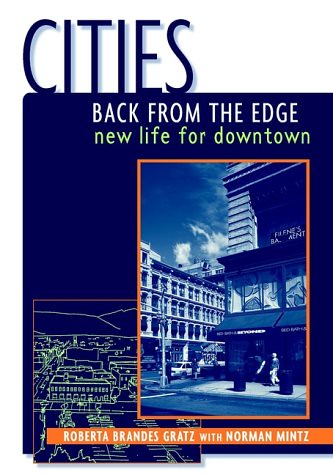 If you have only time to read one book on urban revitalization, Cities Back from the Edge might be the best, clearest, and most straightforward.
If you have only time to read one book on urban revitalization, Cities Back from the Edge might be the best, clearest, and most straightforward.Note that Jane Jacobs, and what I think of as a primer based on her writings, Cities Back from the Edge by Roberta Gratz, called this program of expecting one big splashy building to totally revitalize a place "projects planning," and she criticized the belief that one big project, such as a convention center, stadium etc. was in and of itself enough to spark a broad and deep revitalization of a community.
Barracks Row, 8th Street SE, Capitol Hill. Unlike Kennedy Street, although technically the project has just finished, the streetscape reconstruction of 8th Street SE in Capitol Hill around 2002 is a rare successful example of property and business owners responding independently to a streetscape project by investing in their businesses and accelerating significant and visible positive improvement in the commercial district.
In trying to figure out why the streetscape program worked so well, whereas in many other cases that doesn't happen, I figured out it was because while the commercial district had been lagging economically, it was embedded in a very successful residential neighborhood--Capitol Hill--and the business people understood they could get more business by investing simultaneously with the street improvement projects.
Languishing commercial districts with residential neighborhoods that also are lagging need a deeper and broader revitalization investment program in order to succeed. A one shot project like a streetscape program isn't usually enough.
The Bolling Building on Dudley Square incorporates the facades of three historic buildings and is the headquarters for the school system. Photo by Anton Stassl for the Architectural Record.
Bolling Municipal Building, Dudley Square, Roxbury, Boston. This comes up in today's Boston Globe, "In Dudley Square, battered storefronts undermine the progress," which discusses Dudley Square and how despite the $100 million new city building, the commercial district still lags because of disinvested buildings and empty storefronts. From the article:
Directly across from Boston’s new Bolling Municipal Building is an ugly rebuttal to the years of hard work and the $100 million-plus that activists and city officials have poured into Dudley Square: a grim row of vacant stores.Had some other monies been allocated for investing in nearby properties during the construction period for the new building, likely the results would be different. But instead of doing a focused building by building approach to revitalizing the Square, Councilmembers are pushing a special tax on vacant properties.
Out front is one long unbroken run of rusting metal grates, beat-up signs, and decaying paint, while the area around back is littered with crushed beer cans, pillows, women’s lingerie, and signs of squatters. Down Washington Street are several more vacant storefronts.
“It’s depressing to see,” Annette Hill Green, head attorney at the Donald E. Green law offices in a neighboring, well-kept building. “It doesn’t create the vibrancy you would like to see in a commercial district.”
Long a busy crossroads, Dudley Square received a boost when the city’s school department relocated to the Bolling Building. Officials are now trying to woo restaurants and other businesses to add more life to the area after work hours, and a developer is pushing to build a tower there.
Typically, over time such taxes do end up getting the properties sold to more motivated developers, but that too is a long process that can take a decade or more.
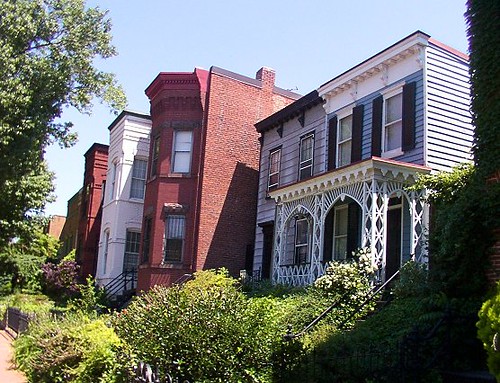 The average price for a house in much of the Capitol Hill residential district exceeds $1 million.
The average price for a house in much of the Capitol Hill residential district exceeds $1 million.Lessons from Barracks Row. In "Systematic Neighborhood Engagement" (2007), I wrote about what I figured out from the successful results on Barracks Row (slightly edited):
An approach I use is based on work done for HUD in the 1970s, and used by most jurisdictions around the country. It's pretty basic, you assess neighborhoods based on whether the neighborhoods are:
1. Healthy
2. Transitioning
3. Emerging
4. Distressed.
based on a set of evaluative criteria.
I think this works for communities with at least 30-50,000 population and higher. (I think the researchers contracted by HUD came up with 5 categories. Philadelphia uses 6. DC 4--although they don't necessarily use the same terms to classify neighborhoods. Charles Buki uses 3 categories. But I think 6-8 is probably the best, because you can have high or low sub-stages within each stage.)
But, you need to do three other things when conducting the analysis, which most places (including DC) don't do:
1. Evaluate separately and simultaneously the commercial district and the residential parts of the neighborhood -- your ability to move the commercial district up the ladder is dependent on the density and economic capacity of the residential district. (And with regard to traditional community development strategies-- building more housing doesn't usually work because more housing for lower income people, while laudable, doesn't build the economic capacity of the neighborhood. You need both a broader range of housing as well as a strengthening of the base of microenterprises employing neighborhood residents and the commercial district, see the Community Economic Development Handbook by Temali.)
2. You can also use the general criteria to evaluate places block-by-block as well, to help develop more focused strategies for specific needs, to move individual properties and blocks forward in a concerted way.
3. Overall, cities should develop differentiated policies for "different" places based on this approach, applied to a categorization of subdistricts and separately for the blocks and buildings within the subdistrict.
Point (3) is crucial and the cause of most failures in government policies and programs. By creating one size fits all programs, and not really understanding the nuances and details of a place and the levers at your disposal, failure is much more likely or at least, success takes two or three times longer.
E.g., emerging and distressed commercial districts aren't likely ready for street furniture given a preponderance of vandalism, and need more assistance in developing community and organizational capacity compared to healthy districts, or those in later stages of transition.
Similarly, even with large investments, it's much harder to move distressed commercial districts up the ladder when the residential neighborhood is also distressed.
… speaking of credit, Rachel MacCleery, the then Ward 6 Transportation Planner now at ULI, and I figured this out together, that commercial districts and residential areas need to be separately and simultaneously evaluated, in order to figure out the likelihood of success.
We were trying to figure out why the investment in streetscape improvement "worked so quickly" on Barracks Row -- 8th Street SE.
Most people don't really understand that the success there isn't merely a function of the investment, but in the overall condition and economic capacity of the greater neighborhood.
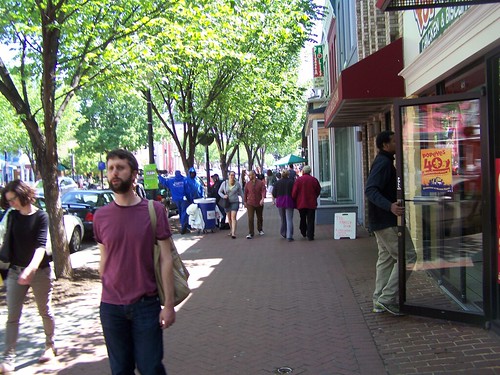 Because much of the property in our commercial districts has absentee ownership, improvement in commercial districts tends to lag improving residential areas, unlike the impact of residential improvement on other building owners (see Building Neighborhood Confidence and Understanding Neighborhood Change both by Rolf Goetze, for more insight into this process).
Because much of the property in our commercial districts has absentee ownership, improvement in commercial districts tends to lag improving residential areas, unlike the impact of residential improvement on other building owners (see Building Neighborhood Confidence and Understanding Neighborhood Change both by Rolf Goetze, for more insight into this process).While the Barracks Row commercial district was "emerging," it was embedded in a residential district that is "Healthy."
The streetscape investment was the cue to the business and property owners to reposition and invest so that the commercial district could catch up to the economic conditions of the healthy residential district within which it is embedded.
In such a situation not a lot of additional public investment is needed. Along the lines of Goetze, the public investment in the streetscape was enough of a cue to spur "neighborhood confidence" on the part of the business owners to invest, and they did.
But when both the residential and commercial districts are lagging, e.g., Emerging/Emerging, etc., more complementary investment needs to be made simultaneous with the big projects otherwise it can take a decade or two to see the results from "trickle down" improvements. And that's even the case in cities like Boston or Washington where the overall economic health is quite high.
Reeves Center. The Boston situation reminds me of what I call "The Reeves Center Myth."
Many people in DC argue that the Reeves Center government building at 14th and U Streets NW is an example of a successful revitalization effort.
While it's true the building replaced an open air drug market that developed on the site after the buildings there had been destroyed in the 1968 riots, the building was constructed in 1986, and revitalization didn't become noticeable until 20 years. In the meantime and afterwards, retail in the building mostly failed and tenants failed to pay their rent to the city.
And the area immediately around the center continued to languish until other new developments elsewhere in the district came about, driving improvements to the blocks at the intersection.
The lesson is that connection to a block and a district is necessary in order to foster improvements across the district. Inwardly-focused developments don't trigger ancillary revitalization.
One building isn't enough.
Urban design and the Waterfront Metrorail buildings. Another example, but positive, is the redevelopment at the Waterfront Metrorail station. Around the station, a large office building and inwardly focused shopping mall had been constructed during the urban renewal era, and as part of the project they cut off 4th Street SW so that it was no longer a through street connecting directly to the Northwest Quadrant, the largest section of the city.
 Plaza around the Waterfront Metrorail station. The building at the upper left of the photo is the side elevation of the Safeway supermarket.
Plaza around the Waterfront Metrorail station. The building at the upper left of the photo is the side elevation of the Safeway supermarket.When the site was redeveloped, the street was reconnected, smaller footprint buildings with a more mixed use character (including housing) were constructed in their place, and the ground floor plane was specifically designed to engage and activate the street.
It's an example of the essentiality of connection as opposed to disconnection when investing in revitalization.
Here, local government agencies did lease a goodly amount of office space, to help seed the success of the new development. But unlike Reeves Center or other examples elsewhere in the city, the buildings were designed to connect to, extend and activate the street, rather than to reject it.
Conclusion. First, subdistricts need to be evaluated in a detailed and nuanced fashion in order to craft successful revitalization plans. These examples demonstrate that a more detailed approach is required, focused on the characteristics of what the real estate industry calls submarkets.
So the Capitol Hill submarket is different from the Anacostia submarket or the Kennedy Street submarket. Lessons can still be shared across districts with different conditions, but it is only knowing about those difference that commonalities can be discerned.
Second, new buildings that are supposed to be augurs of revitalization need to be designed in ways that connect to and activate the street, rather than disconnect from it. The Reeves Building is an example of disconnection. Boston's Bolling Building is better than urban renewal, but still isn't enough.
Third, most often a single building or a streetscape reconstruction on its own isn't enough to spark broader revitalization, unless the conditions of the commercial and residential districts are highly favorable.
Generally, complementary "transformational projects action plans" need to be developed façade improvement programs, business development grants, technical assistance, and other initiatives are usually needed to foster allied investment in private properties and to facilitate improvement across the district beyond the new project.
And surprisingly even seemingly very successful submarkets like Dupont Circle need "intervention" and support in the face of competition from other districts within the city and the metropolitan area ("Dupont Circle, a place steeped in history, gets a new look and new investment," Washington Post). Again, this comes down to a subdistrict approach focused on fundamentals. While Dupont Circle is more successful than Kennedy Street, it faces a different set of competitors that provide different challenges.
Just because a place like Dupont Circle is better off comparatively speaking to an impoverished area doesn't mean that plans, implementation organizations, and investment programs aren't required.
Other districts in the same situation include Alexandria ("Alexandria businesses discuss opportunity, competition at The Wharf," Alexandria Times), Takoma Park vis a vis Silver Spring, etc.
Labels: public investment, traditional commercial districts, Transformational Projects Action Planning, urban design/placemaking, urban revitalization





1 Comments:
https://www.theguardian.com/business/2018/jun/26/cities-replace-shops-offices-housing-report
Post a Comment
<< Home